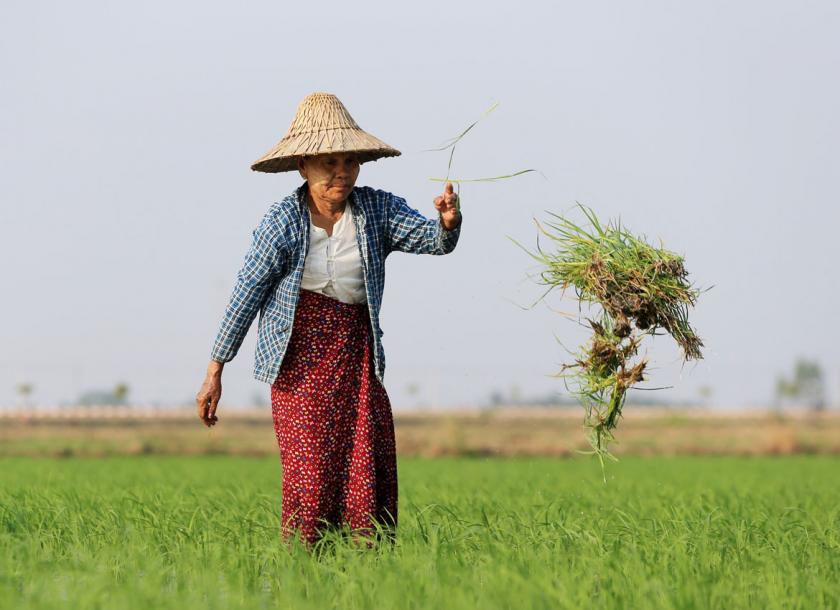Myanmar: Driven by agriculture, first half GDP growth forecast at 7.2pc
Myanmar’s GDP growth is forecast to hit 7.2 percent during the first six months of 2018 under the National Planning Law, which was signed and approved by President U Htin Kyaw on March 8 and announced Monday.
That is up from GDP growth of 6.2pc in the first six months of 2017. As such, achieving the target level of 7.2pc over the same period this year, “will not be too difficult,” U Maung Maung Tint, Director General from the Planning Department under the Ministry of Planning and Finance, told The Myanmar Times.
“This year’s six-month forecast was made based on last year’s growth figures and the possibility of new projects this year,” he said.
According to preliminary statistics, the Myanmar economy grew at a rate of 6.8pc for the 2017-18 fiscal year, falling short of the government’s 7pc target. “Although the target was not met, the GDP growth rate is still not too bad,” U Maung Maung Tint said.
Agriculture push
For the first six months of this year, much of the estimated GDP growth is expected to come from agriculture. “The agriculture sector will be made to become more productive. This is the one sector in which returns are the quickest.
Moreover, we have a considerable amount of experience in the farming sector,” said U Maung Maung Tint.
“As such, we will channel investments into this sector and change the seeds we use for cultivation to better suit weather conditions. If we can do that, growth in the agriculture sector is projected to more than double to 3.5pc this year compared to 1.3pc this year,” said U Maung Maung Tint.
Furthermore, if things are improved, other sectors, such as the industrial and transportation sectors, are expected to benefit, too, he added.
Agriculture is currently among the largest contributors to Myanmar exports after the industrial sector, according to the Ministry of Commerce.
The sector contributes around 20pc to the country’s GDP, compared to around 35pc generated in the industrial sector.
Under the National Plan, the agriculture sector is expected to grow at 3.5pc during the next months. Other sectors, including electricity and energy, transportation, finance, construction and industry as well as trade are also expected to grow strongly. Only the forestry sector is expected to slow.
 Yangon is expected to grow by 8.6pc over the next six months. Zarni Phyo/The Myanmar Times
Yangon is expected to grow by 8.6pc over the next six months. Zarni Phyo/The Myanmar Times
Growth in the Regions and States
Of the States and Regions, the economies of Yangon and Mandalay have been forecast to grow by 8.6pc each over the next six months, representing the fastest growing regions in the country.
Kachin State, which enjoys the most natural resources, is expected to chart a growth rate of just 2.8pc over the period. That’s lower than the other Regions and States of the country, which are expected to grow between 5pc and 7pc, according to the National Plan.
During the period, imports are expected to total K9.7 trillion, exceeding exports of K9.3 trillion. That’s a trade deficit of around K400 billion, according to the plan.
Meanwhile, public sector investments are estimated to amount to around K2.9 trillion during the six months. The projects implemented under national planning will include those that promote ethnic unity, national unity and law enforcement.
The projects will be implemented in line with the country’s economic policy and the respective departments and organisations must prioritise investments that yield immediate and sustainable results for the country and its citizens, according to the National Planning Law.
The projects must also be assessed for their feasibility and viability and must be supportive of local development as well as avoid harming the environment. They must also receive prior approval from the Union Government.
The National Plan includes a long term 20-year National Comprehensive Development Project as well as shorter term projects of between 1-5 years.
The projects include those in the various sectors and across the Region and States. They will also include special development projects such as human resource development, economic zones and special economic zones, industrial development, industrial based farming development, investment development, urban and rural area development and border area development projects.
Source: https://www.mmtimes.com/news/driven-agriculture-first-half-gdp-growth-forecast-72pc.html


 Thailand
Thailand




